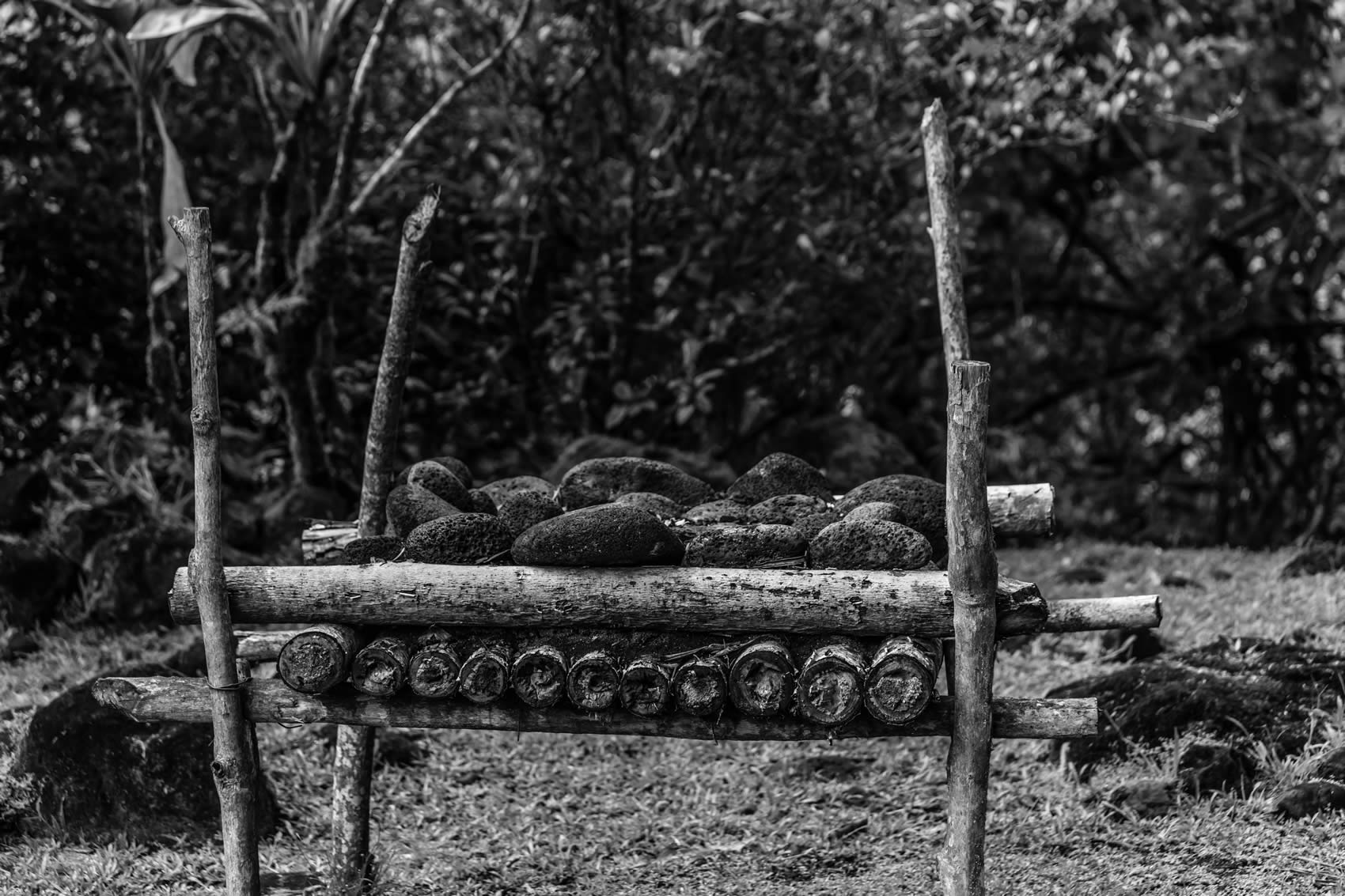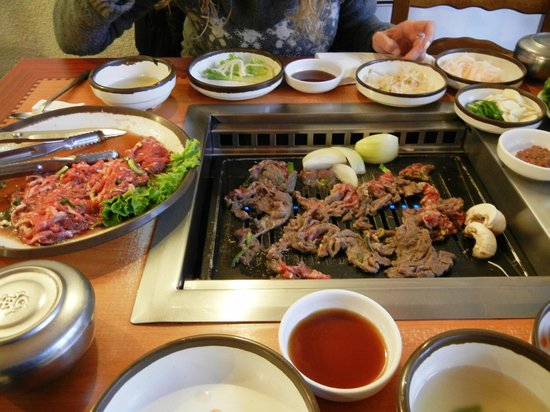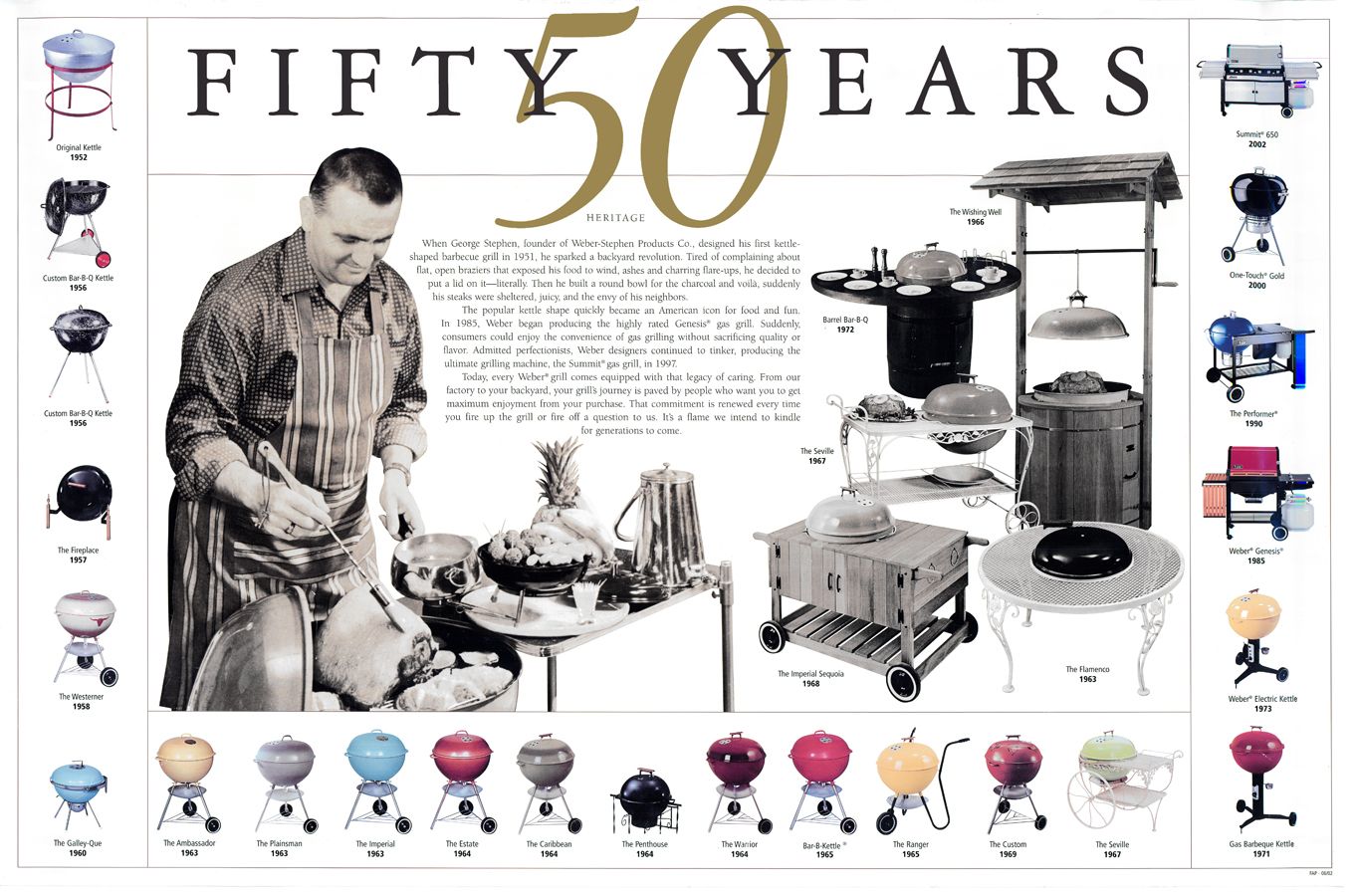
Origin, history of barbecues

Origin, history of barbecues

Origin, history of barbecues

Origin, history of barbecues
Legend has it that barbecue was invented centuries ago in a small French town after a dispute between a baron and the master blacksmith who had to make a fence around his castle. The iron craftsman miscalculated the diameter of the fence and ended up with a good surplus of metal. The nobleman refused to pay for the excess iron. It was then that, as a vindictive claim, the blacksmith was given meat to cook day and night in front of the castle, using part of the remaining steel as a support as a grid. The baron ended up disbursing the two ducats demanded by the blacksmith.
Asado is actually an invention as old as fire (in fact, if humanity has survived to this day, it has been thanks to having learned to cook), but if it is to be attributed to paternity, the patent should be in the hands of the Tainos. Settled on the islands of the Caribbean, the Taínos used a utensil made of green logs to cook the meat of their hunts that they placed over the flames of a dreaded fire in a longitudinal hole. They referred to this primitive kitchen gadget as barbacúa, a term that with the arrival of the Spanish settlers also became used to describe the cooking technique through the heat radiated by embers or flames. Another theory is that the word barbecue comes from the Caribbean area and means "wattle" (weaving of rods, reeds or reeds) or "scaffolding" that is placed inside the oven. The word is recorded for the first time in the "Collection of unpublished documents of the Archivo de Indias" in 1518 where we can read: "Certain chiefs came out with their people with many roasted deer and put on their barbecues, which means like troughs from there or instruments in which a lot of roasted and cooked meat can be carried. "The two most generalized theories about the origin of the word barbecue are: the first that comes from the Mayan Baalbak'Kaab (meat covered with earth) and the second that originates from the Taíno Caribbean Barabicu (meat cooked on wooden scaffolding).
That way of cooking ended up spreading throughout the world. From Argentine asados to the multiple variants of the United States, China and its char siu, the Mongolian scrambled or the Korean güi, the khorovats from Armenia, the Turkish mangal ... barbecue is no longer a simple meat preparation system, fish and vegetables for, whether it is fired with firewood, charcoal or gas, become a social event. Nothing better than a sunny day in the company of friends, some hot embers and a good cut of meat accompanied by a cold beer or two.
And who came up with the practical grid? In 1832 an amnesty was approved in Uruguay, whereby thousands of political prisoners and common criminals were released. The Law was welcomed with great celebrations throughout the country. Especially popular were the celebrations in the presidios, especially in the Colonia de Sacramento jail, where the ex-convicts knocked down the prison walls and took various cattle from the residents of the area. To cook them, a prisoner ripped open the door of his cell and with it made what they say was the first modern barbecue. That is the constant battle they maintain for the paternity of facts and events; this theory is contested by their Argentine neighbors. They say that since the middle of the 19th century, in the surroundings of the Río de la Plata, the gauchos used to roast the meat of the skinned animals the iron grates that were usually used to dry skins and hides. That, they say, is the true origin of modern barbecues. An invention of one or the other, the only certainty is that roasts (for them the term barbecue is a sacrilege) are a very serious thing in the area (as in Chile, Paraguay, southern Brazil, Bolivia ...).
The truth is that after much searching in the history of barbecues, we have to say that it is not known for sure who invented it, nor when was the right moment of its appearance as such, it is believed that the concept of cooking with embers arises in the century of the Middle Ages, with the preparation of whole animals made by fire.

Korean barbecue
In the Southern Cone, where they enjoy some of the best meats in the world, the gauchos have been and continue to be the guardians of the essences when it comes to roasts. All families have their grill master, and when they get involved with a barbecue, an act that, due to the work it involves and the after-dinner gatherings they generate, can go on for hours and hours, it will be this and only this who is in charge of the correct performance of the liturgy. The gaucho Martín Fierro, the protagonist of a classic of Argentine literature such as the homonymous narrative poem, written by José Hernández in 1872, used to say that “every bug that walks will end up on the grill”. However, as a general rule, roasts - of which there are three variants: cross, spit or stake - are usually made from beef, the most common cuts being the rib - or strip roast - and the vacuum. Once the meat is done, they cut it with a facón and eat it ‘al pan’. In the case of being finer or city people, the option is ‘al plato’.
For their part, the ancient Maya had a cooking method that they called baalba koab. At a depth of one meter they modeled a cylindrical oven. In it they placed charcoal, on the charcoal, green logs, on these, a ceramic bowl in which the juices of the cooked meat precipitated, and finally, a new row of logs. And now, on top of this second wooden grill, covered with agave leaves, the fillets. Finally, they closed the oven with a circular stone that they sealed with clay and allowed the chicha to roast with heat and steam for four or five hours. This modernized system (which is still used in many areas of Mexico, modernized) evolved until it found the current barbecues of New Mexico and Texas (for many, the best barbecue in the world), where they grill meat (the favorite cuts of the locals are brisket, sausages and pork ribs marinated with salt and pepper) in brick ovens. However, in the United States, especially in the south of the country, there are many ways to barbecue. In Florida, for example, smoked ones are characteristic. In South Carolina the secret is in the sauce, always with a pinch of mustard. In Georgia, where the grill and oven alternate, its Brunswick stew is legendary, combining various pieces of smoked meat with beans, tomato and corn. Lexington, North Carolina, has proclaimed itself the barbecue capital of the world. A tour of its many exquisite grills certifies this. They are not far behind in Missouri. Home of the American Royal World Series of Barbecue, something like the world championship of barbecues, here life follows the rhythm of the slow fire that marks its barbecue. And, obviously, we could not ignore Memphis, Tennessee, and its cuts of pork cooked in wood-fired ovens for more than 20 hours and served with a barbecue sauce where the protagonism falls on the vinegar seconded by a touch of tomato and various hot spices.
Here we put a few of the most popular sauces:
Kansas City: thick, red-brown tomato molasses.
South Carolina: vinegar, mustard, black pepper.
North Carolina: liquid vinegar, pepper flakes.
Alabama: white mayonnaise.
Texas: tomato sauce with hot chilies and cumin.
Tabasco: Spicy sauce originally from the U.S.A made with fermented chili and vinegar.
Arkansas: fine tomato and vinegar sauce with pepper and molasses.

Weber barbecue
Nowadays many people use the terms barbecue and grill interchangeably, but the best thing to distinguish between them is to refer to the term barbecue to which it has a lid, with this an oven effect is achieved and refer to the grill to which it does not have a lid It is similar but there are quite a few differences in the roasting process and in the result.
Grill cooking is a faster and hotter process than barbecue, which is done with little color and much slower.
To the United States, we owe the democratization of barbecues, universalization for which a man named George Stephen is largely responsible. In the late 1940s Stephen was working as a welder for the Weber Brothers Metal Works company. His main task in the company was to weld two steel half spheres with which they made buoys. When the weather was nice, there was no weekend without a barbecue at the Stephen's. But good old George was out of his mind that when a little wind blew, steaks, sausages, and hamburgers were covered in a nasty layer of ash. It was then when it occurred to him to take the lower part of one of the buoys that he manufactured, weld three legs to it and add the upper half sphere as a cover. Baptized by George's neighbors as 'Sputnik' because of its satellite appearance, the modern family barbecue was born. Currently, the Weber-Stephen Products Co., a company that this entrepreneur founded together with his former bosses to market his invention, is indisputably the world's benchmark barbecue brand.
On the other hand, and after kimchi, Korean barbecue has been the one that has been the most successful in recent years among hunters of gastronomic trends. Their roasts in Korea are generically called güi, a word derived from the term gupda which literally means grill. Koreans make güi from meat, fish and vegetables. Meat barbecues, whether they are beef, pork, chicken or even pheasant, are the gogi güi. The traditional way to make them is with a small charcoal grill located in the center of the table. Once the meat is cooked, it is cut into small pieces and wrapped in a lettuce leaf along with rice, garlic and other seasonings such as gochujang and doenjang. Saengseon güi is the barbecue of fish, being especially appreciated by Korean gourmets those of eel (jangeo güi), verdel (godeungeo güi), scallop (garibi güi) or prawn (daeha güi). Vegetable barbecues are also very popular, such as the matsutake songi güi, the mushroom beoseot güi or the seaweed gim güi.
The barbecue also has a reserved place in the Chinese and Mongolian cookbook. In China, the cha siu, which is Cantonese-style barbecue, triumphs. Made from pork, the secret of its delicacy is not so much grilled as it is due to the sauce with which the meat is watered while it roasts. The marinade formula includes sugar or honey, five-spice powder, soy sauce, and sherry or rice wine. The charshu is its Japanese version. The main characteristic of the Japanese adaptation is that the meat or fish is not roasted but boiled (well, it's not a barbecue) and the oil is made only of soy sauce and honey, which gives it a more flavor sweetish than Chinese barbecue. Stir frying is the particular Mongolian barbecue method. Also very similar to Japanese teppanyaki, on a brick oven in which the embers are hidden, a round iron plate of about eight feet in diameter is placed where mainly meats and vegetables are roasted.
Between Asia and Europe, Armenia and Turkey also have their barbecue variants, the khorovat for the former and the mangal for the Ottomans. There is an Armenian saying that “you earn enough money if you can invite your friends to three khorovats a month”. The khorovat is one of the most deeply rooted culinary customs in the country, a typical barbecue on holidays and large banquets. It is made mainly with lamb meat (although pork has been gaining prominence in recent decades). The pieces are cut into cubes and put into the embers inserted into shampoors, which is what they call skewers in Armenia. Perhaps because of the smoke that the barbecues raise, in Armenia it is a sign of good manners not only to tell the neighbors that you are going to spend a good part of the day making a khorovat, but also to "bribe" them with various skewers so that they do not complain. A similar liturgy accompanies the preparation of the Turkish mangal, a variant of barbecue that from Istanbul has spread to other countries in the Middle East. Typical for outdoor meals with friends or family, the mangal –which was originally the name that in the Ottoman empire was given to the indoor stoves used to heat food– is also prepared on skewers and is usually served with salad, lowering them with a glass of salgam, a very traditional drink in Turkey, especially in the south of the country, made from the juice of pickled carrots and seasoned and seasoned with a kind of aromatic kohlrabi called çelem. Come on, a drink only suitable for the brave.